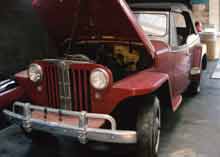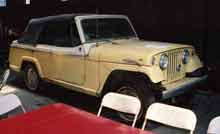Where’d you get those Jeepsters? The Larz Anderson Auto Museum in Brookline, Massachusetts, got them through its Collector Car Program, where donated cars are sold to help finance museum operations and recycle cars back to the enthusiast community.
This 1949 car is from the
first Jeepster generation, 1948-50. Originally powered with the 134 cubic inch
“Go Devil” engine from the Universal Jeep, the Jeepster got an optional
six-cylinder engine in ’49. This Jeepster is unusual, however, for it has
four-wheel drive.
Four-wheel drive Jeepsters didn’t regularly appear until the second generation, the
Jeepster Commando of 1967. The Commando, based on the CJ-6 chassis, came in four body styles, roadster,
station wagon,
pickup and
convertible. Power came from the F-head Willys Hurricane Four, and a Dauntless V6, adopted from Buick, was optional. In the transition period from Kaiser to American Motors ownership, AMC engines were substituted, and the V6 was eventually sold back to General Motors. The Jeepster, later simply “Commando”, was discontinued after 1973. This Jeepster Commando is a 1967 model with the
V6 and
automatic transmission (the bulletproof Turbo 400 Hydra-Matic). It is
not pristine, but is an unusual vehicle that would make a nice project. The Museum is asking $2,500 for it; contact Collector Car Program Manager Andy Jeffrey if it appeals to you.
The
’49 Jeepster has already been sold, but what about that four-wheel drive? My explanation is that someone transplanted the Jeepster body onto the chassis of a 1954 Willys four-wheel drive station wagon. The Jeepster and wagon wheelbases differ by a mere half-inch. There must have been some interference, though, for the pedal arrangement is
quite peculiar.
Both first and second generation Jeepsters have constituencies. There are at least two clubs for the early Jeepsters, the Willys-Overland Jeepster Club in Massachusetts and the Midstates Jeepster Association in Michigan. The American Jeepster Club caters to the needs of Jeepster Commando owners. Their website has a wealth of information on both the Kaiser and AMC models.


